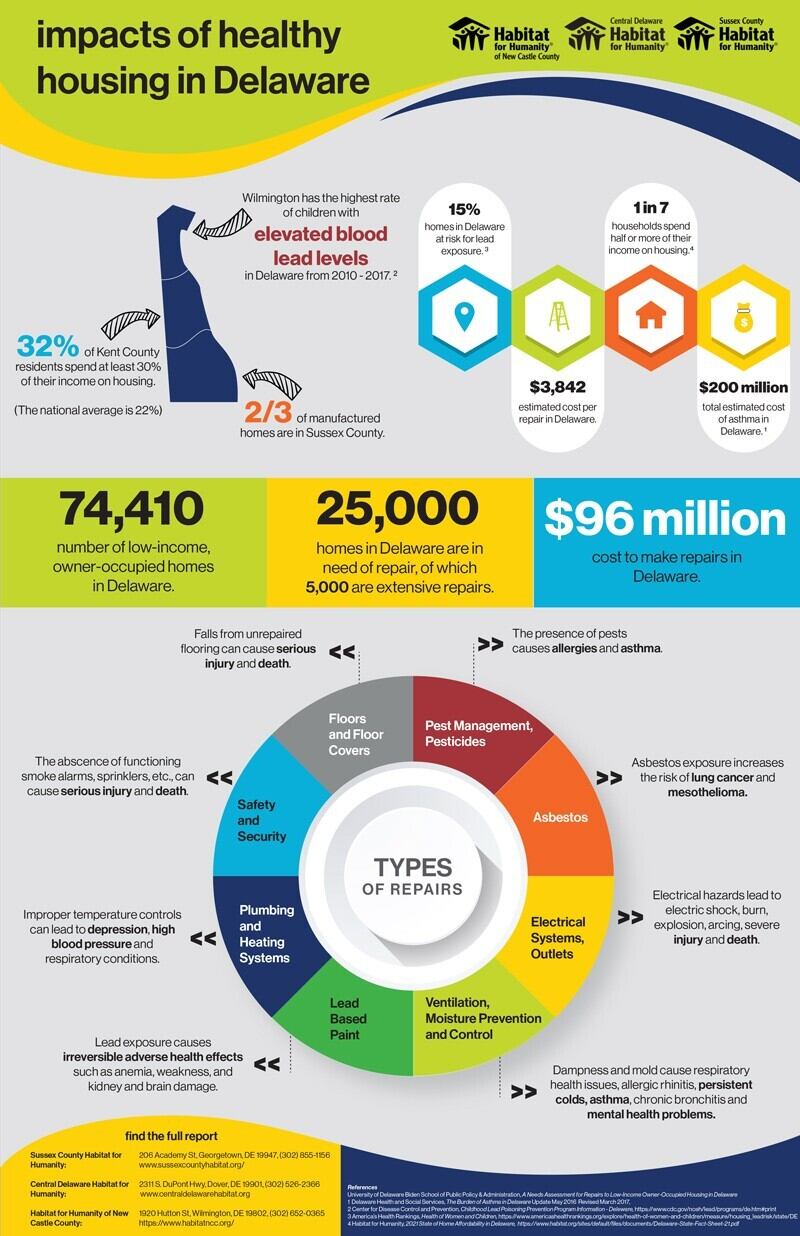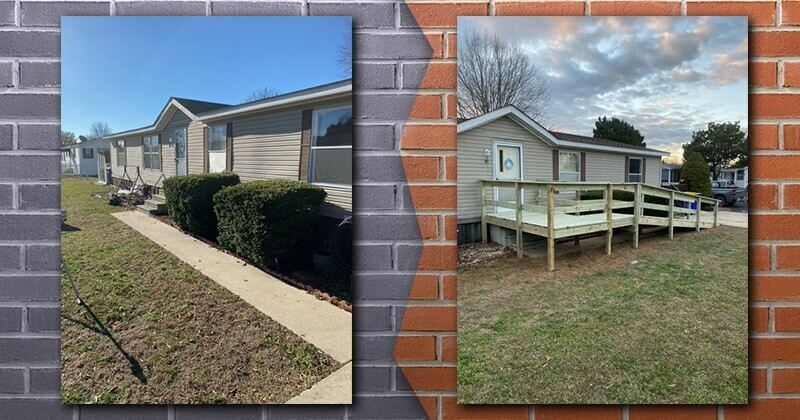
UD Biden School researchers partner with Habitat for Humanity to assess the repair needs of owner-occupied homes in Delaware
Across the nation affordable and accessible housing stock is in limited supply, making the need to maintain existing homes even more critical. In Delaware, there are 25,000 homes owned by low-income households that are in need of repair, and 5,000 of these homes are in need of extensive work. The total price tag for doing this work is estimated at $96 million.
These estimates come from a report called, “A Needs Assessment for Repairs to Low-Income Owner-Occupied Housing in Delaware,” released last December that was commissioned by Delaware’s three Habitat for Humanity organizations representing each of the state’s counties. The study was carried out by a University of Delaware research team from the Center for Community Research and Service (CCRS) and the Institute for Public Administration (IPA). Both of these organizations are research and public service centers in the Joseph R. Biden, Jr. School of Public Policy and Administration.
The report assesses the need for home repair assistance, and the role of such repairs, in a broader solution to the state’s rising affordable housing crisis. The information provided by the report will inform priorities for Delaware’s Habitat for Humanity affiliates and help them address this need for repairs.
The research team comprised Stephen Metraux, director of CCRS; Roger Hesketh, director of community revitalization, CCRS; Sean O’Neill, policy scientist, IPA; Mimi Rayl, housing initiatives coordinator, CCRS; and Alexander Modeas, a graduate student in the master of arts in urban affairs and public policy program.
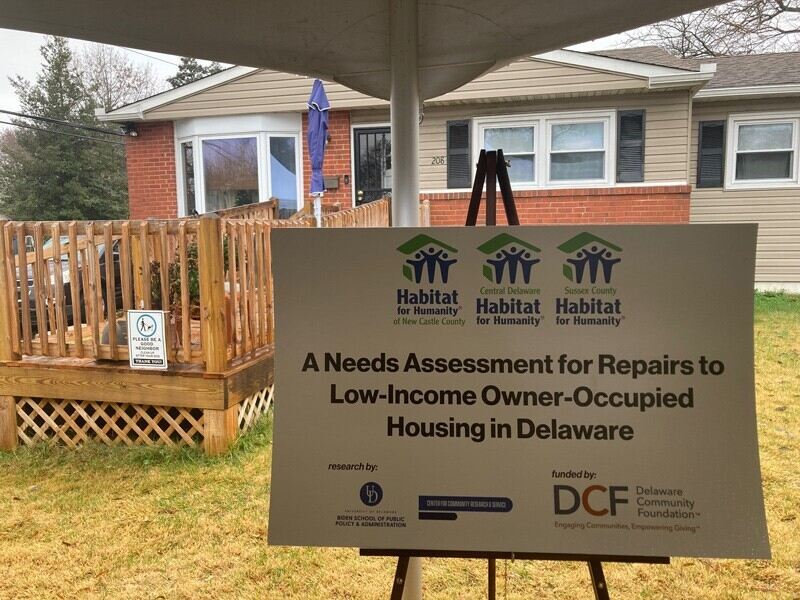
Substandard housing poses a risk to the health, safety and physical well-being of occupants, neighbors and visitors of homes and can lead to detrimental health issues if left unaddressed for a long period of time. This study highlighted the role that housing repair in home-owner occupied units could have in mitigating Delaware’s housing crisis and improving public health outcomes.
“The data contained in the study helps to complete the story of housing needs as we know it. The need is real,” said Kevin Gilmore, chief executive officer of Sussex County Habitat for Humanity. While new housing developments throughout the state will increase housing stock, this study brought to light the challenges of aging housing for present homeowners.
“For each home that is repaired, that is one less house that needs to be built, which helps to increase the affordable housing stock that is available for Delawareans,” said Stephen Metraux, lead author on the report. “Home repair is affordable housing. These are homes owned by families of modest means who have trouble maintaining home repairs or have home repairs that have been postponed and have accumulated. Providing assistance to homeowners for these repairs is a critical piece to address the affordable housing crisis.”
According to the report, “As any homeowner quickly realizes, home repairs are part of homeownership. Things break, wear out, and need to be replaced. Many households have resources set aside for this, or can come up with resources to make these repairs.” However, not all households have the capacity to manage timely maintenance and repairs, and some homes simply reach the end of their usable lifespan. Therefore, financial status can often be a determining contributor to who can afford housing restoration and who cannot.
“One really important thing that we have learned is the full scope of the need,” said Katie Millard, director of development and advocacy for Habitat for Humanity of Sussex County. “Habitat can give more anecdotal evidence including the homes they see, and the people who come to the program. The study gave an exact cost and amount of units that needed to be fixed.” A total of $54 million worth of home repairs needed in New Castle County, $27.4 million in Sussex County, and $15.4 million in Kent County.
“Without those numbers or understanding the scope of need in Delaware, this issue probably” wouldn’t be addressed directly, Millard said. This analysis provides more information, credibility and concrete numbers to move funding forward for homeowners in need of severe housing repairs.
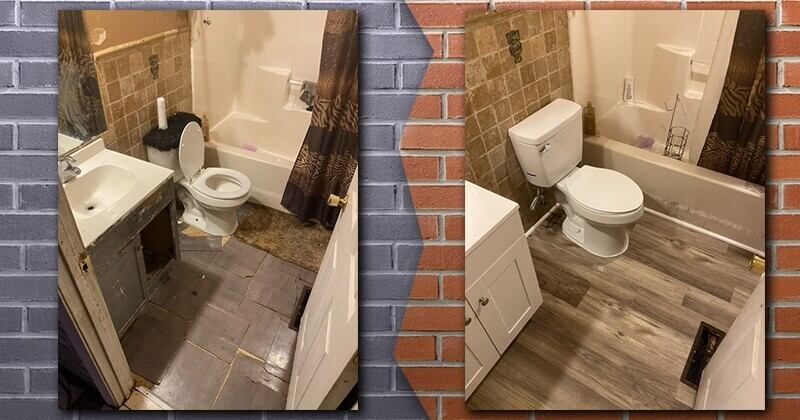
Low-income, elderly, disabled, and Black and Latino populations are more likely to live in substandard housing because they lack access to affordable healthy housing options. The study noted, “Homeowners who are of racial and ethnic minority groups, particularly [Black people], have persistently occupied lower quality homes, a result of historic and ongoing structural discrimination.”
Discriminatory practices such as “...unequal access to credit, exclusion from housing markets, and geographic separation from areas of predominantly White homeownership, where homes are often newer and of better quality, and credit is more accessible.” As a result of these historical and discriminatory practices, the disenfranchisement of many communities can be seen in areas heavily populated by lower-income and Black and Latino families.
This report was the focus of a Biden School-sponsored webinar held on Dec. 13, 2022, called "Healthier Housing: Addressing Substandard Housing for Delaware Homeowners" webinar. The keynote speaker in the webinar was Matthew Heckles, the Region III Administrator for the US Department of Housing and Urban Development (HUD). He joined Metraux, Gilmore, Kevin Smith (chief executive officer of Habitat for Humanity of New Castle County) and Tim Bailey (executive director of Central Delaware Habitat for Humanity) to discuss the report’s findings and the need to address substandard housing.
Gilmore noted during the webinar that for Sussex County in particular, “there is a disproportionate amount of manufactured homes,” which are houses that do not have the same foundational structure as traditional homes. Manufactured homes have a significantly shorter intended life and frequently begin falling apart much earlier than other homes. Manufactured homes also tend to be more susceptible to issues such as natural disasters or flooding, making them an even larger risk in an area such as Sussex County. By developing housing programs that directly address these critical needed repairs, Habitat for Humanity helps provide homeowners with the necessary funds to maintain current homes.
Heckles reported that some owners of substandard aging homes experience, “issues with lead paint in older homes especially in communities of color, and that the Office of Lead Hazard Control and Healthy Homes is [committed] to remedying these issues by increasing accessibility for senior citizens and finding ways to improve their quality of life [by helping them to remain in their homes], instead of being moved to assisted care facilities.”
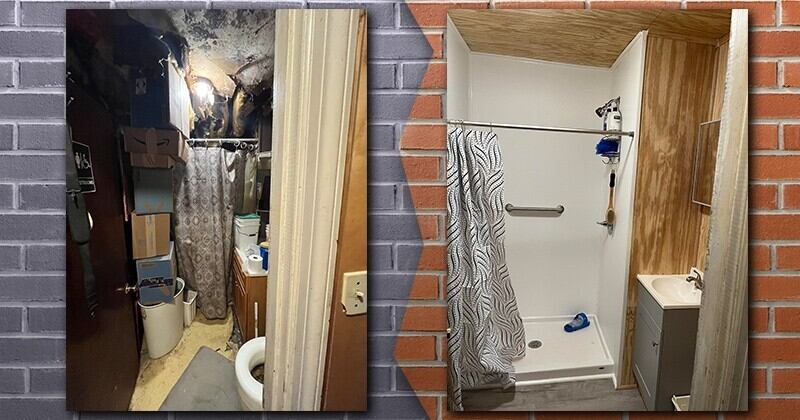
As Delaware’s population ages, the need for home repairs and modifications continues to grow. According to the report “homeownership comes with the responsibility for maintaining the home, which can become increasingly more challenging as people age and confront physical and financial limitations, the latter of which includes living on fixed, retirement incomes.” Aging adults may have difficulty going up and down the stairs, walking over worn carpeting, and maneuvering in the bathroom. Thus, “older adults may experience more hazards in their house that can negatively affect their health.”
“We cannot build our way out of the affordable housing crisis,” Gilmore said. Repairs and improvements are needed, such as “Replacing roofs, grab bars, reducing trip and fall hazards,” to make housing safe for senior citizens.
According to Millard, a huge portion of the population that Habitat for Humanity serves includes senior citizens. Many of them are on a fixed income that can prevent them from being able to afford these repairs.
Tim Bailey explained the challenges that they face in Kent County, which has the highest level of poverty and lowest income in the state. Bailey noted that it is critical to help Kent’s large population of senior citizens age in place rather than being displaced due to home repair needs. “There is a great need for revitalization and repair so with this study it will help Habitat for Humanity to be more focused, guided and more proactive than reactive,” to the issues that Delaware homeowners face, said Bailey.
While a homeowner may have originally had the resources needed to purchase a property, changes in health or socioeconomic status make home repairs a challenge.
The report noted, “Age of a structure is one of the most direct indicators of its need for physical improvements and repairs. As homes age, they become more prone to depreciation in value as they physically deteriorate or are in locations that become less desirable.” These housing conditions often result in a process called “filtering,” which means “owners leave older homes in pursuit of more desirable housing, and the homes they left behind are priced to where they are more affordable to lower-income homebuyers.”
While at first glance, filtering may seem to be a bargain for low-income families, it can lead to a slew of challenges once they have made their home purchases. The report stated that, “...these lower income households may have less means and ability to properly maintain this housing at the same time that aging housing requires more upkeep.” Essentially, these conditions can then perpetuate a cycle where “substandard housing can contribute to poor health outcomes, which in turn can exacerbate poor economic outcomes.”
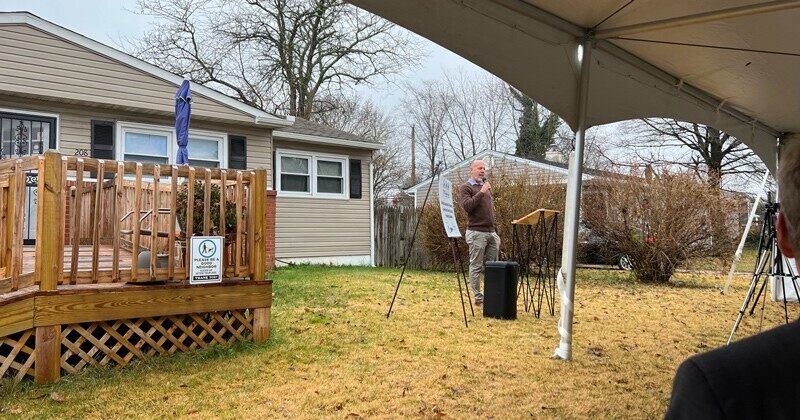
Poor health outcomes that result from substandard housing conditions impact our medical system, so in that sense these conditions impact everyone. According to the National Center of Healthy Housing, “Research has shown that each dollar invested would result in a return of $2.03 to reduce asthma triggers at home, $1.39 for lead paint hazard control, and $1.33 for removing lead service lines.”
The University research team's report is a launching point for the Habitat for Humanity affiliates' grant applications and new programming to directly provide healthier housing for Delaware residents.
“This data will help the collaboration amongst the three Habitat for Humanity programs to provide citizens with the ability to remain in their homes for longterm without having to be displaced,” Kevin Smith said.”
About the Center for Community Research and Service
The Biden School's Center for Community Research and Service works to create more just and equitable communities and enhance the wellbeing of underserved populations in Delaware and beyond. Our research engages with communities and the health and social service systems serving them, thereby contributing to identifying solutions and improving policy. Our public service strengthens the ability of our partners to improve the wellbeing of their communities. Our teaching and professional development builds and supports community leaders and researchers.
About the Institute for Public Administration
The University of Delaware's Institute for Public Administration (IPA) addresses the policy, planning and management needs of its partners through the integration of applied research, professional development and the education of tomorrow's leaders. As a research and public service center in the Joseph R. Biden, Jr. School of Public Policy and Administration, IPA collaborates with state agencies, municipal governments, nonprofits, communities and businesses to examine complex policy issues and improve quality of life in Delaware and beyond.
